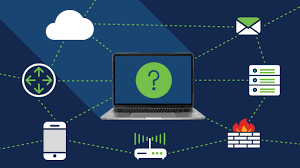Advanced Tools for Network Pentesting
Network penetration testing (pentesting) is an essential practice for identifying and addressing vulnerabilities within an organization's IT infrastructure. The effectiveness of a pentest largely depends on the tools used by the testers. Advanced tools offer sophisticated capabilities that enable thorough and efficient testing, providing deep insights into network security. This article explores some of the most advanced tools used in network pentesting, highlighting their key features, functionalities, and real-world applications.
1. Nmap (Network Mapper)
Nmap is a powerful open-source tool widely used for network discovery and security auditing. It provides detailed information about the hosts and services on a network, making it an essential tool for network mapping and vulnerability scanning.Key Features:
- Host Discovery: Identifies live hosts on a network.
- Port Scanning: Determines open ports and associated services.
- Version Detection: Detects versions of services running on network devices.
- OS Detection: Identifies the operating system of target hosts.
- Scripting Engine: Automates various tasks using Nmap Scripting Engine (NSE).

Real-World Application: Nmap is frequently used in the initial stages of pentesting to map the network, identify live hosts, and gather information about open ports and services. For example, a cybersecurity company might use Nmap to scan a corporate network, identifying potential entry points and services running on different devices.
2. Metasploit Framework
Metasploit is a comprehensive penetration testing platform that provides tools for exploiting vulnerabilities, developing and executing exploit code, and conducting extensive security assessments.Key Features:
- Exploit Database: Contains a vast repository of known exploits.
- Payloads: Offers various payloads to execute after exploiting a vulnerability.
- Auxiliary Modules: Includes additional tools for scanning, fuzzing, and more.
- Meterpreter: An advanced payload that provides a command-line interface for interacting with the target system.
- Post-Exploitation Modules: Tools for gathering information and maintaining access after exploitation.
Real-World Application: Metasploit is used for exploiting vulnerabilities identified during the scanning phase. For example, after discovering a vulnerability in a web server, testers might use Metasploit to exploit the flaw and gain access to the server, demonstrating the potential impact of the vulnerability.
3. Wireshark
Wireshark is a widely-used network protocol analyzer that allows testers to capture and interactively browse the traffic running on a computer network. It is essential for analyzing network protocols and diagnosing issues.
Key Features:
- Deep Inspection: Analyzes hundreds of protocols in real-time.
- Live Capture: Captures network traffic from live networks.
- Offline Analysis: Allows for analysis of previously captured traffic.
- Filtering and Search: Advanced filtering options to focus on specific traffic.
- Visualizations: Provides graphical representations of network traffic.

Real-World Application: Wireshark is used to analyze traffic patterns, identify anomalies, and troubleshoot network issues. During a pentest, Wireshark might be employed to capture and analyze traffic between a client and server to identify unencrypted sensitive data or potential vulnerabilities in the communication protocols.
4. Burp Suite
Burp Suite is a comprehensive platform for web application security testing. It includes various tools for performing automated and manual testing of web applications.Key Features:
- Proxy: Intercepts and modifies traffic between the browser and the target application.
- Scanner: Automated scanner for finding vulnerabilities in web applications.
- Intruder: Tool for automating customized attacks.
- Repeater: Allows for manual testing of individual requests.
- Extender: Extends Burp Suite's capabilities through plugins.
5. Nessus
Nessus is a widely-used vulnerability scanner that helps identify vulnerabilities, misconfigurations, and compliance issues in networks and applications.Key Features:
- Comprehensive Scanning: Scans for a wide range of vulnerabilities.
- Configuration Audits: Assesses configurations against industry standards.
- Compliance Checks: Ensures compliance with various regulatory requirements.
- Risk Assessment: Prioritizes vulnerabilities based on their severity and impact.
- Reporting: Generates detailed reports for remediation.

6. OpenVAS (Open Vulnerability Assessment System)
OpenVAS is an open-source framework for comprehensive vulnerability scanning and management. It is known for its extensive database of network vulnerabilities.Key Features:
- Extensive Vulnerability Database: Continuously updated database of vulnerabilities.
- Custom Scans: Allows for customized scans tailored to specific requirements.
- Reporting: Generates detailed reports for vulnerability management.
- Credentialed Scanning: Provides deeper insights by using credentials to access and scan systems.
- Integration: Integrates with other security tools and management systems.
7. Aircrack-ng
Aircrack-ng is a suite of tools for assessing the security of wireless networks. It focuses on monitoring, attacking, testing, and cracking Wi-Fi networks.Key Features:
- Packet Capture: Captures packets from wireless networks.
- WEP and WPA Cracking: Cracks WEP and WPA-PSK keys to access wireless networks.
- Replay Attacks: Performs replay attacks to test the security of wireless networks.
- Deauthentication: Deauthenticates clients to capture WPA handshake.
- Monitoring: Monitors wireless network traffic for analysis.
8. John the Ripper
John the Ripper is a fast and versatile password-cracking tool. It is used to detect weak passwords and improve password security.Key Features:
- Password Cracking: Supports various password cracking techniques, including dictionary attacks, brute force attacks, and rainbow tables.
- Extensible: Supports a wide range of encryption formats and can be extended with additional modules.
- Multi-Platform: Available on multiple platforms, including Windows, Linux, and macOS.
- Performance Optimization: Optimized for performance to crack passwords efficiently.

9. Hydra
Hydra is a parallelized login cracker that supports numerous protocols to attack. It is used to perform brute force attacks on login pages and authentication mechanisms.Key Features:
- Protocol Support: Supports a wide range of protocols, including HTTP, FTP, SSH, Telnet, and more.
- Brute Force and Dictionary Attacks: Performs brute force and dictionary attacks to crack passwords.
- Parallelized Attacks: Uses multiple threads to perform attacks simultaneously, improving efficiency.
- Extensible: Can be extended with additional modules to support new protocols and features.
10. Zed Attack Proxy (ZAP)
ZAP is an open-source web application security scanner maintained by OWASP. It is designed to find vulnerabilities in web applications and APIs.Key Features:
- Automated Scanning: Automatically scans web applications for vulnerabilities.
- Manual Testing: Provides tools for manual testing and analysis.
- API Testing: Supports testing of REST and SOAP APIs.
- Intercepting Proxy: Intercepts and modifies traffic between the browser and the web application.
- Active and Passive Scanning: Performs both active and passive scanning to identify vulnerabilities.


